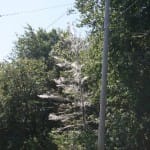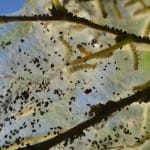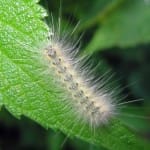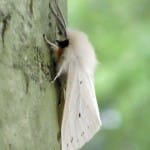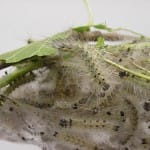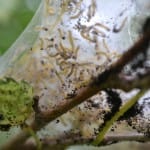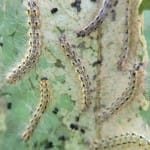Source(s): Willie O Chance
Two types of caterpillars make webs in trees. The Eastern tent caterpillar makes webs in the forks of the branches. They are more of a problem early in the spring. The fall webworm makes their webs on the ends of the branches and is more prevalent in the late summer and fall. Fall webworms are the most visible since their webs are located on the end of the branches. Their webs remain in the tree after the webworms leave and the webs can collect until there are many in a tree.
Fall Webworms Description
Fall webworms can be up to one inch long. They come in two color forms. Those with black heads are yellowish white while those with red heads are brown. Fall webworms are covered with long, soft gray hairs.
Fall Webworms Behavior
Fall webworms will feed on more than 100 types of trees but they prefer trees like pecans, black walnut, mulberry, elm, sweetgum, willow, apple, ash and oak. I most often see them in pecan trees.
The caterpillars form fine silken webs on the ends of the branches. They will enlarge the webs if they need more leaves. They feed on the leaves in these webs for a couple of weeks before they leave the trees to become pupae. These pupae eventually turn into a white moth. This moth may have black spots. This moth can fly away to lay eggs on trees to start another generation of webworms. There can be up to four generations of fall webworms in a year. The webworms survive the winter as pupae in cocoons in protected places.
These caterpillars feed on the leaves of the tree. This hurts the tree some but the tree should recover. Healthy trees are able to withstand a great deal of insect damage to their leaves without lasting injury. I would not be concerned about insects feeding on healthy trees unless most of the leaves were gone. If trees are weakened, webworm infestation may damage or kill the tree.
Healthy trees can usually stand the loss of almost all their leaves and still live. This is true of most deciduous trees (trees that lose their leaves in the fall) but not needled, evergreen trees like pines, cedars, junipers and other conifers. Evergreen trees with needles cannot withstand the loss of their leaves and must be better protected against loss of leaves. Fortunately, webworms do not like to attack needled evergreen trees.
Fall Webworms Control
Since most trees will not die from caterpillar attack, I do not generally recommend spraying. If you want to control the caterpillars by spraying, you must treat the entire tree – perhaps more than once. You will usually need to hire a tree service to do this. The person treating the tree will need to find some way to get the insecticide inside the webs to kill the caterpillars. For these reasons I generally suggest that we just live with these worms a while. They will eventually leave.
If you do decide to spray; use insecticidal soap, horticultural oils or Bacillus thuringiensis to kill small caterpillars. These insecticides are less likely to kill the natural predators that keep the levels of these webworms low. These chemicals are not good at killing large caterpillars. Watch the southern-most branches of trees in early spring to find the webs before the caterpillars get large. For larger caterpillars, use a chemical like cyfluthrin or bifenthrin. Once again – find a way to get the insecticide into the webs for best control.
Some people cut the branches off or burn out these webs. This may damage the tree more than the caterpillars would. I do not recommend that you do this. Put up with the fall webworms for a while and they should go away on their own.
Resource(s):
